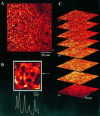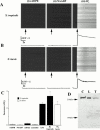Xenopus tropicalis oocytes as an advantageous model system for the study of intracellular Ca(2+) signalling
- PMID: 11264232
- PMCID: PMC1572681
- DOI: 10.1038/sj.bjp.0703922
Xenopus tropicalis oocytes as an advantageous model system for the study of intracellular Ca(2+) signalling
Abstract
1. The purpose of this study was to compare oocytes from the pipid frogs Xenopus tropicalis and Xenopus laevis, with respect to their utility for studying Ca(2+) signalling mechanisms and for expression of heterologous proteins. 2. We show that X. tropicalis oocytes possess an intracellular Ca(2+) store that is mobilized by inositol (1,4,5) trisphosphate (IP(3)). Ca(2+) signalling is activated by endogenous lysophosphatidic acid receptors and cytosolic Ca(2+) activates a plasma membrane chloride conductance. The spatiotemporal organization of cytosolic Ca(2+) signals, from the microscopic architecture of elementary Ca(2+) 'puffs' to the macroscopic patterns of Ca(2+) spiking are closely similar to the local and global patterns of Ca(2+) release previously characterized in oocytes from X. laevis. 3. By injecting X. tropicalis oocytes with cDNA encoding an ER-targeted fluorescent protein construct, we demonstrate the capacity of the X. tropicalis oocyte to readily express heterologous proteins. The organization of ER is polarized across the oocyte, with the IP(3)-releaseable store targeted within an approximately 8 microm wide band that circumscribes the cell. 4. We conclude that the X. tropicalis oocyte shares many of the characteristics that have made oocytes of X. laevis a favoured system for studying Ca(2+) signalling mechanisms. Moreover, X. tropicalis oocytes display further practical advantages in terms of imaging depth, Ca(2+) signal magnitude and electrical properties. These further enhance the appeal of X. tropicalis as an experimental system, in addition to its greater amenability to transgenic approaches.
Figures








Similar articles
-
Intracellular targeting and homotetramer formation of a truncated inositol 1,4,5-trisphosphate receptor-green fluorescent protein chimera in Xenopus laevis oocytes: evidence for the involvement of the transmembrane spanning domain in endoplasmic reticulum targeting and homotetramer complex formation.Biochem J. 1997 Apr 1;323 ( Pt 1)(Pt 1):273-80. doi: 10.1042/bj3230273. Biochem J. 1997. PMID: 9173893 Free PMC article.
-
Picomolar sensitivity to inositol trisphosphate in Xenopus oocytes.Cell Calcium. 2015 Nov;58(5):511-7. doi: 10.1016/j.ceca.2015.08.003. Epub 2015 Aug 20. Cell Calcium. 2015. PMID: 26344104 Free PMC article.
-
Modulation of endoplasmic reticulum Ca2+ store filling by cyclic ADP-ribose promotes inositol trisphosphate (IP3)-evoked Ca2+ signals.J Biol Chem. 2010 Aug 6;285(32):25053-61. doi: 10.1074/jbc.M109.095257. Epub 2010 Jun 10. J Biol Chem. 2010. PMID: 20538594 Free PMC article.
-
Calcium puffs in Xenopus oocytes.Ciba Found Symp. 1995;188:50-60; discussion 60-5. doi: 10.1002/9780470514696.ch4. Ciba Found Symp. 1995. PMID: 7587623 Review.
-
Elementary events of InsP3-induced Ca2+ liberation in Xenopus oocytes: hot spots, puffs and blips.Cell Calcium. 1996 Aug;20(2):105-21. doi: 10.1016/s0143-4160(96)90100-1. Cell Calcium. 1996. PMID: 8889202 Review.
Cited by
-
cADPR stimulates SERCA activity in Xenopus oocytes.Cell Calcium. 2009 Mar;45(3):293-9. doi: 10.1016/j.ceca.2008.11.008. Epub 2009 Jan 7. Cell Calcium. 2009. PMID: 19131109 Free PMC article.
-
Using fluorometry and ion-sensitive microelectrodes to study the functional expression of heterologously-expressed ion channels and transporters in Xenopus oocytes.Methods. 2010 May;51(1):134-45. doi: 10.1016/j.ymeth.2009.12.012. Epub 2010 Jan 4. Methods. 2010. PMID: 20051266 Free PMC article. Review.
-
Fluorescence lifetime imaging reveals heterogeneous functional distribution of eGFP expressed in Xenopus oocytes.Methods Appl Fluoresc. 2019 Nov 13;8(1):015001. doi: 10.1088/2050-6120/ab51f8. Methods Appl Fluoresc. 2019. PMID: 31658452 Free PMC article.
-
Heterologous Protein Expression in the Xenopus Oocyte.Cold Spring Harb Protoc. 2018 Apr 2;2018(4):pdb.prot096990. doi: 10.1101/pdb.prot096990. Cold Spring Harb Protoc. 2018. PMID: 29208643 Free PMC article.
-
Essential requirement for two-pore channel 1 in NAADP-mediated calcium signaling.J Cell Biol. 2009 Jul 27;186(2):201-9. doi: 10.1083/jcb.200904073. Epub 2009 Jul 20. J Cell Biol. 2009. PMID: 19620632 Free PMC article.
References
-
- AARHUS R., GEE K., LEE H.C. Caged cyclic ADP-ribose. J. Biol. Chem. 1995;270:7745–7749. - PubMed
-
- AMAYA E., OFFIELD M.F., GRAINGER R.M. Frog genetics: Xenopus tropicalis jumps into the future. Trends Genet. 1998;14:253–255. - PubMed
-
- BEREITER-HAHN J., VÖTH M. Dynamics of mitochondria in living cells: shape changes, dislocations, fusion, and fission of mitochondria. Microscopy Res. Technique. 1994;27:198. - PubMed
Publication types
MeSH terms
Substances
Grants and funding
LinkOut - more resources
Full Text Sources
Miscellaneous

